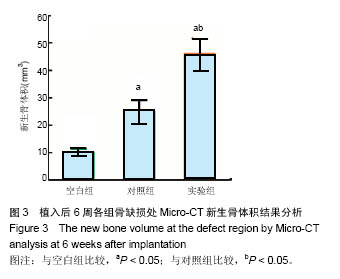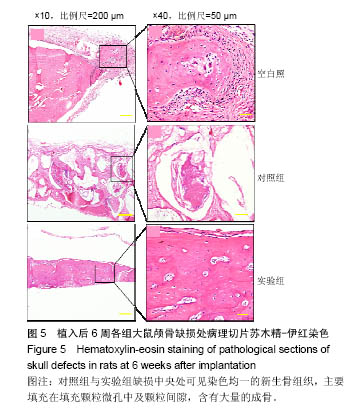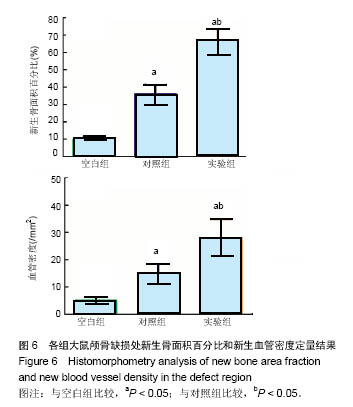| [1]Finkemeier CG.Bone-grafting and bone-graft substitutes.J Bone Joint Surg Am.2002;84-A(3): 454-464.[2]Dorozhkin SV.Bioceramics of calcium orthophosphates. Biomaterials.2010;31(7):1465-1485.[3]Doblaré M,Garc?a JM,Gómez MJ.Modelling bone tissue fracture and healing: a review.Eng Fract Mech. 2004;71 (13-14):1809-1840.[4]Tatara AM, Mikos AG.Tissue Engineering in Orthopaedics.J Bone Joint Surg.2016;98(13):1132-1139.[5]Jeon OH,Elisseeff J.Orthopedic tissue regeneration: cells, scaffolds, and small molecules.Drug Deliv Transl Res. 2016; 6(2):105-120.[6]Bastami F,Nazeman P,Moslemi H,et al.Induced pluripotent stem cells as a new getaway for bone tissue engineering: A systematic review.Cell Prolif.2017;50(2).doi: 10.1111/cpr.12321. Epub 2016 Dec 1.[7]Kimelman N,Pelled G,Helm GA,et al.Review: Gene- and Stem Cell–Based Therapeutics for Bone Regeneration and Repair.Tissue Eng.2007;13(6):1135-1150.[8]Discher DE, Mooney DJ,Zandstra PW.Growth factors, matrices, and forces combine and control stem cells. Science. 2009;324(5935):1673-1677.[9]Burg KJ,Porter S,Kellam JF.Biomaterial developments for bone tissue engineering.Biomaterials. 2000;21(23): 2347-2359.[10]Bose S,Roy M,Bandyopadhyay A.Recent advances in bone tissue engineering scaffolds.Trends Biotechnol. 2012;30(10): 546-554.[11]Ma PX.Biomimetic materials for tissue engineering.Adv Drug Deliv Rev.2008;60(2):184-198.[12]Fernandez-Yague MA,Abbah SA,McNamara L,et al.Biomimetic approaches in bone tissue engineering: Integrating biological and physicomechanical strategies.Adv Drug Deliv Rev.2015;84:1-29. [13]Henstock JR,Canham LT,Anderson SI.Silicon: The evolution of its use in biomaterials.Acta Biomaterialia. 2015; 11:17-26.[14]Liu W,Zhang J,Rethore G,et al.A novel injectable, cohesive and toughened Si-HPMC (silanized-hydroxypropyl methylcellulose) composite calcium phosphate cement for bone substitution.Acta Biomaterialia.2014; 10(7):3335-3345.[15]Lin K,Liu Y,Huang H,et al.Degradation and silicon excretion of the calcium silicate bioactive ceramics during bone regeneration using rabbit femur defect model. J Mater Sci Mater Med. 2015;26(6):197.[16]Khan AF,Saleem M, Afzal A,et al.Bioactive behavior of silicon substituted calcium phosphate based bioceramics for bone regeneration.Mater Sci Eng C Mater Biol Appl.2014;35: 245-252.[17]Shadjou N,Hasanzadeh M.Silica-based mesoporous nanobiomaterials as promoter of bone regeneration process.J Biomed Mater ResA.2015;103(11):3703.[18]Alfotawei R,Naudi KB,Lappin D,et al.The use of TriCalcium Phosphate (TCP) and stem cells for the regeneration of osteoperiosteal critical-size mandibular bony defects, an in vitro and preclinical study.J Craniomaxillofac Surg. 2014; 42(6):863-869.[19]Samavedi S,Whittington AR,Goldstein AS.Calcium phosphate ceramics in bone tissue engineering: A review of properties and their influence on cell behavior.Acta Biomaterialia. 2013; 9(9):8037-8045.[20]Choo T, Marino V,Bartold PM.Effect of PDGF-BB and beta-tricalcium phosphate (β-TCP) on bone formation around dental implants: a pilot study in sheep.Clin Oral Implants Res. 2013;24(2):158-166.[21]Fujihara K,Kotaki M,Ramakrishna S.Guided bone regeneration membrane made of polycaprolactone/calcium carbonate composite nano-fibers.Biomaterials. 2005;26(19): 4139-4147.[22]Causa F,Netti PA,Ambrosio L,et al.Poly-epsilon-caprolactone/ hydroxyapatite composites for bone regeneration: in vitro characterization and human osteoblast response.J Biomed Mater Res A.2006;76(1):151-162.[23]Yeo MG,Kim GH.Preparation and Characterization of 3D Composite Scaffolds Based on Rapid-Prototyped PCL/β-TCP Struts and Electrospun PCL Coated with Collagen and HA for Bone Regeneration.Chem Mater.2012;24(5):903-913.[24]Wu C.Methods of improving mechanical and biomedical properties of Ca-Si-based ceramics and scaffolds.Expert Rev Med Devices.2009;6(3):237-241. [25]Ni S,Chang J,Chou L.A novel bioactive porous CaSiO3 scaffold for bone tissue engineering.J Biomed Mater Res A. 2006;76(1):196-205.[26]Bohner M,Gbureck U,Barralet JE.Technological issues for the development of more efficient calcium phosphate bone cements: A critical assessment.Biomaterials.2005; 26(33): 6423-6429.[27]Chow LC.Next generation calcium phosphate-based biomaterials.Dent MaterJ.2009;28(1):1-10. [28]Ginebra MP,Espanol M,Montufar EB,et al.New processing approaches in calcium phosphate cements and their applications in regenerative medicine.Acta Biomaterialia. 2010;6(8):2863-2873.[29]Dash TK, Konkimalla VB.Poly-?-caprolactone based formulations for drug delivery and tissue engineering: A review.J Control Release.2012;158(1):15-33.[30]Labet M,Thielemans W.Synthesis of polycaprolactone: a review.Chem Soc Revi.2009;38(12):3484.[31]Kim J,McBride S,Donovan A,et al.Tyrosine-derived polycarbonate scaffolds for bone regeneration in a rabbit radius critical-size defect model.Biomed Mater. 2015;10(3): 035001.[32]Sears NA,Seshadri DR,Dhavalikar PS,et al.A Review of Three-Dimensional Printing in Tissue Engineering.Tissue Eng Part B Rev.2016;22(4):298-310. [33]Black CM,Goriainov V,Gibbs D,et al.Bone Tissue Engineering. CurrMol Biol Rep.2015;1(3):132-140.[34]Amini AR,Laurencin CT,Nukavarapu SP.Bone tissue engineering: recent advances and challenges. Crit Rev Biomed Eng.2012;40(5):363-408.[35]Zhao L,Burguera EF,Xu HH,et al.Fatigue and human umbilical cord stem cell seeding characteristics of calcium phosphate–chitosan–biodegradable fiber scaffolds. Biomaterials. 2010;31(5):840-847. [36]Khan AF,Saleem M,Afzal A,et al.Bioactive behavior of silicon substituted calcium phosphate based bioceramics for bone regeneration.Mater Sci Eng C Mater Biol Appl.2014;35: 245-252. [37]Vila M,García A,Girotti A,et al.3D silicon doped hydroxyapatite scaffolds decorated with Elastin-like Recombinamers for bone regenerative medicine.Acta Biomater.2016;45:349-356. [38]Avolio E,Alvino VV,Ghorbel MT,et al.Perivascular cells and tissue engineering: Current applications and untapped potential. Pharmacol Ther.2017;171:83-92. |
.jpg)






.jpg)